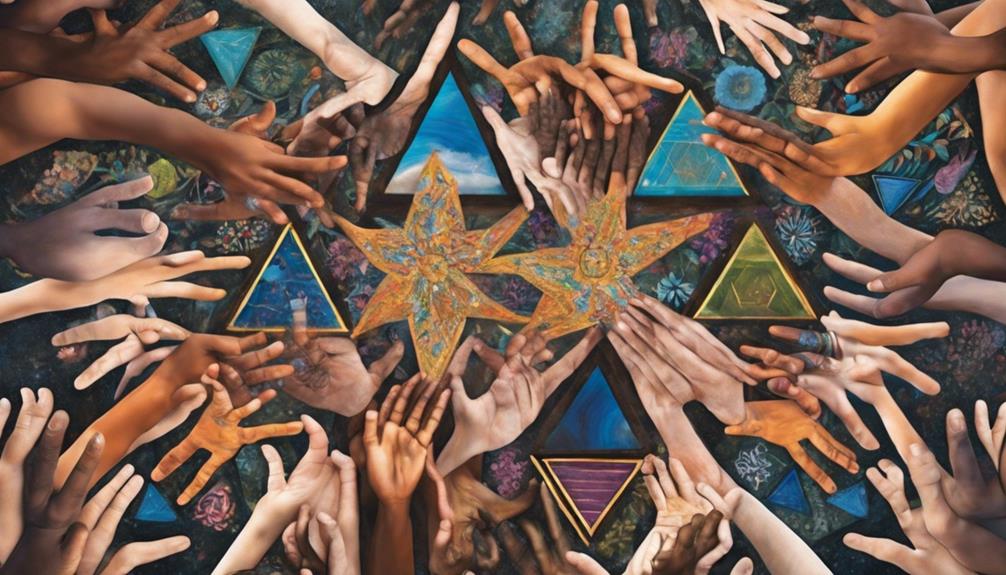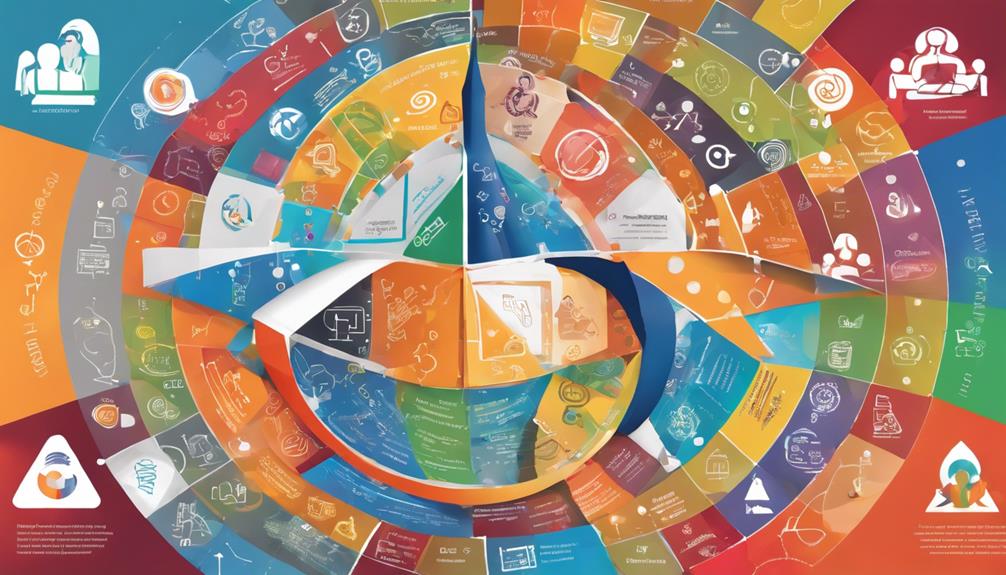Integrating Cultures in Triangular Mergers

Integrating diverse cultures in a triangular merger requires a thoughtful and strategic approach. The process involves aligning the distinct organizational cultures while recognizing and appreciating the unique strengths of each entity involved.
It is crucial to foster collaboration and establish open communication channels to ensure a smooth integration. Respecting cultural nuances and understanding power dynamics within the merged organization is also essential.
Effective leadership plays a critical role in managing cultural change during a triangular merger. By implementing a tailored integration plan that combines the different cultures while preserving essential elements, leaders can help facilitate a successful transition.
Leveraging Prosci's expertise in change management and empowering sponsors to drive the transformation process can further support the integration efforts.
Overall, navigating the complexities of cultural integration in a triangular merger requires a nuanced and empathetic approach. By embracing the diversity of the merging entities and actively addressing cultural differences, organizations can unlock the full potential of the newly combined entity.
Through proactive leadership, open communication, and a tailored integration strategy, companies can successfully blend cultures and create a cohesive and collaborative environment.
Key Takeaways
When navigating a triangular merger, it is essential to develop a tailored integration plan that takes into account the distinct cultural nuances of each organization involved. By understanding and respecting the unique values and practices of each entity, you can create a collaborative environment that promotes unity and a shared organizational culture.
Clear communication channels should be established to encourage cross-cultural dialogues among the three organizations. This open dialogue is crucial for bridging any gaps, addressing disparities, and fostering mutual understanding. By promoting effective communication, you can lay a strong foundation for a successful integration process.
Change management expertise plays a vital role in aligning the top teams, defining integration priorities, and addressing cultural differences in a systematic manner. Leveraging this expertise will help ensure a smooth transition and facilitate the merging of diverse organizational cultures.
Empowering sponsorship with strategic foresight and cultural awareness is key to crafting a unifying framework that respects the distinct identities of each organization while celebrating the strengths that each brings to the table. By recognizing and valuing these differences, you can create a cohesive and inclusive organizational culture.
Implementing cultural sensitivity training and fostering collaborative problem-solving can help harness the innovation and creativity potential of a multicultural workforce in the combined entity. By encouraging employees to work together and leverage their diverse perspectives, you can unlock new opportunities for growth and success in the merged organization.
Challenges of Triangular Mergers
Navigating the intricate cultural dynamics of triangular mergers presents significant challenges for organizations. Balancing the distinct organizational cultures of three entities requires careful consideration of power dynamics and inherent differences among the involved parties. Cultural integration is crucial but complex when three unique organizational cultures need to be seamlessly combined.
Triangular mergers pose distinct hurdles in fostering collaboration and overcoming resistance to change. Managing the delicate power dynamics is essential to ensure no single entity dominates the others. Effective change management plays a vital role in aligning the values, beliefs, and behaviors of these three distinct organizations.
Conducting comprehensive cultural assessments is essential to gain deep insights into the nuances of each company's culture. This understanding allows for the development of a tailored integration strategy to harmonize the diverse organizational cultures involved in the merger.
Triangular mergers require exceptional execution and coordination to achieve the desired cultural alignment and business synergies.
Aligning Diverse Organizational Cultures
We understand the importance of having a multicultural workforce in triangular mergers. Embracing diversity is key to creating a successful cross-functional collaboration.
It's crucial to undergo organizational transformation to align these diverse cultures effectively. By developing a new shared culture that integrates the strengths of each company involved, we can unlock the full potential of these intricate mergers.
Valuing Multicultural Workforce
Understanding the significance of embracing the diversity present in a multicultural workforce is crucial when aligning the unique organizational cultures that come together in a triangular merger.
It's important to acknowledge the value of creating an inclusive environment that appreciates diverse perspectives and backgrounds to fully leverage the synergies that can arise from the merger. By promoting a culture of respect and understanding, we can tap into the innovative thinking and problem-solving skills that multicultural teams offer.
Celebrating the cultural differences of each organization enables us to construct a more unified and cooperative merged entity. Effective communication, along with a willingness to adapt and learn from one another, plays a key role in integrating these distinct organizational cultures.
As we navigate the complexities of merging cultures, our commitment lies in empowering our multicultural workforce and utilizing their unique insights to drive innovation and accomplish our strategic goals. This comprehensive approach to cultural management is foundational to the success of our triangular merger.
Fostering Cross-Functional Collaboration
When it comes to triangular mergers, fostering collaboration across functions is crucial. It involves aligning the diverse organizational cultures of the merging entities. By integrating different values, beliefs, and behaviors, we can create a cohesive new culture. This strategic approach is essential for harmonizing cultural differences and maximizing synergy potential.
To succeed in integration, it's important to cultivate a shared vision and establish a common language that can bridge cultural gaps. Emphasizing employee engagement, cultural fit, and alignment among leaders is key to navigating the complexities of managing culture across functions. Through cross-functional collaboration, we can harness diverse perspectives and expertise, leading to innovation and successful integration.
Ultimately, fostering cross-functional collaboration is vital for triangular mergers. By aligning organizational cultures, we unlock the full potential of the merger and build a stronger, more resilient entity. This collaborative approach is essential for organizations aiming to thrive in dynamic, multicultural environments.
Embracing Organizational Transformation
Understanding the distinct identities and historical backgrounds of the organizations involved is essential when aligning diverse organizational cultures in triangular mergers. It's crucial to bridge cultural gaps, fostering a collaborative and unified organizational culture that reflects the best aspects of all three entities.
This process begins by comprehending the values, beliefs, and behaviors that define each company's identity, paving the way for a successful cultural transformation.
Embracing organizational transformation is a critical element for the seamless integration of companies in triangular mergers. Cultural alignment requires a tailored strategy that respects the unique nuances of each organization involved.
Importance of Culture in M&A

Culture plays a crucial role in M&A transactions. Ignoring cultural fit can result in the departure of key talent and hinder the overall success of the merger. This is why it's vital to comprehend and address cultural disparities to facilitate a seamless and prosperous integration process.
In a triangular merger, three companies are involved in the transaction, unlike a traditional merger where only two companies are merging. This type of merger can offer various strategic advantages, such as expanding market reach and diversifying product offerings. Triangular mergers often require a more complex integration process due to the involvement of multiple entities, making cultural alignment even more critical for success.
Research shows that companies that prioritize cultural integration in M&A activities are more likely to achieve their strategic and financial goals. By investing time and resources in understanding and managing cultural differences, organizations can create a cohesive post-merger culture that drives employee engagement and innovation.
Organizational Culture Alignment
Organizational culture plays a crucial role in the success of triangular mergers, acting as the cohesive force that unites companies and creates a collaborative environment. Understanding the importance of cultural integration is key to aligning values, beliefs, and behaviors across all entities involved in the merger.
Achieving successful cultural alignment in triangular mergers necessitates a profound comprehension of each organization's distinct culture to identify synergies and potential conflicts.
Effective communication is essential in enhancing dialogue and promoting shared understanding among the merging companies. Collaboration is equally critical as it fosters teamwork and facilitates knowledge sharing, ultimately leading to a more cohesive and productive work environment.
The ability to adapt to change is paramount in triangular mergers, allowing companies to navigate transitions and challenges effectively. Moreover, engaging employees throughout the merger process is vital for boosting morale and fostering organizational commitment.
Cultural Due Diligence
Triangular mergers require a thorough examination of the cultures of the three companies involved to ensure a successful integration. Understanding the leadership styles, communication norms, and decision-making processes of each organization is crucial in identifying cultural strengths and weaknesses. By evaluating these aspects early on, we can develop a strategy to align the cultures effectively and promote collaboration during the integration phase.
Assessing cultural differences and similarities is essential for the positive outcome of a triangular merger. By proactively addressing any cultural challenges, we can facilitate a seamless transition and maximize the benefits of the merger.
Our cultural due diligence process involves a comprehensive analysis of the values, beliefs, and behaviors of each company, allowing us to pave the way for a unified and high-performing culture. This approach enables us to leverage the unique strengths of each organization, driving innovation and long-term success in the merged entity.
Cross-Cultural Communication
Cross-cultural communication plays a crucial role in triangular mergers. It's vital to understand the unique communication styles, decision-making processes, and leadership approaches of each organization involved.
By acknowledging and respecting these cultural differences from the outset, potential misunderstandings and conflicts during the integration phase can be minimized, fostering collaboration and trust among diverse teams.
Effective cross-cultural communication is essential for the success of integration in triangular mergers. Being culturally sensitive and aware allows for the identification of synergies and the alignment of goals across the merging entities.
Tailoring communication strategies to fit each culture aids in the smooth integration process, ensuring that all stakeholders are on the same page. Prioritizing cross-cultural understanding enables the merger to leverage the distinct strengths and perspectives of each entity fully.
Integrating cultures in triangular mergers presents a complex challenge. However, mastering cross-cultural communication is key to navigating these challenges successfully and emerging stronger than ever before.
Strategic Approach to Cultural Integration
Crafting a smart strategy for blending cultures in triangular mergers involves carefully merging different organizational cultures while maintaining their fundamental aspects. This delicate equilibrium is crucial for boosting teamwork, communication, and overall organizational effectiveness.
Our strategy comprises three essential components:
- Conducting a thorough evaluation of the cultural nuances within the three merging organizations to pinpoint synergies and disparities.
- Creating a customized integration plan that capitalizes on the strengths of each culture while reducing conflicts and disruptions.
- Establishing clear and consistent communication channels to encourage comprehension, alignment, and a cohesive organizational identity.
Leadership in Managing Cultural Change

Leaders play a crucial role in managing cultural change, especially in the context of a triangular merger where three distinct organizational cultures are coming together. Their proactive approach is key to successfully navigating the complexities that arise from merging diverse cultures.
Understanding the unique cultural identities of each merging entity is fundamental for leaders. By identifying the core values and practices that should be preserved from each culture, they can create a cohesive organizational culture that leverages the strengths of all three.
Effective communication and clear guidance are essential for leaders to guide employees through the integration process. By articulating a compelling vision that inspires and fosters a sense of shared purpose, leaders can ensure alignment and unity among the teams.
In the realm of triangular mergers, visionary leadership is the linchpin for managing cultural change. By celebrating diversity, establishing common ground, and promoting shared norms, leaders can pave the way for a successful integration that benefits all parties involved.
Communicating Effectively During Integration
Effective communication plays a crucial role in the successful integration of diverse cultures in a triangular merger. Clear and transparent communication serves as the foundation for bridging cultural gaps and promoting collaboration among the merging entities. It's essential to tailor communication strategies to consider cultural differences and ensure that all stakeholders grasp the integration process.
Open dialogue and regular updates are key in mitigating misunderstandings and resistance during the cultural integration phase. By addressing specific cultural nuances in our communication, we can significantly enhance the success of integrating cultures in triangular mergers. Prioritizing communication allows us to align diverse cultures and establish a shared vision for the combined organization.
Effective communication isn't merely a best practice but a necessity in the context of triangular mergers. By proactively addressing cultural differences and fostering open dialogue, we can navigate the complexities of the merger process and emerge with a more cohesive and stronger organization.
Overcoming Barriers to Cultural Alignment

Identifying the cultural differences between the three merging organizations is crucial in a triangular merger. Understanding the unique values and norms of each entity is the first essential step. Once we've a clear picture of these distinctions, we can work towards creating a harmonious and integrated organizational culture that reflects the best aspects of each company.
By recognizing the individual cultural identities within the merging organizations, we can pave the way for a smooth transition towards a unified culture. It's imperative to acknowledge and respect the diverse backgrounds and traditions that each company brings to the table. This acknowledgment sets the foundation for a collaborative effort in developing strategies that blend the distinct cultures into a cohesive whole.
In a triangular merger scenario, the focus shifts towards leveraging the strengths of each organization's culture to create a new, shared identity. This process involves aligning values, communication styles, and organizational practices to foster unity and cohesion.
Identify Cultural Differences
Understanding and managing cultural differences in triangular mergers requires a keen awareness of the distinct organizational backgrounds and practices involved. It's essential to recognize and analyze these significant cultural disparities to pave the way for a successful integration.
Key aspects to consider include:
- Conflicting values, beliefs, and behavioral norms that originate from the merging entities' individual histories and corporate cultures.
- Varied communication styles, decision-making processes, and conflict resolution strategies.
- Misaligned priorities, incentive structures, and performance metrics that may lead to challenges during the integration phase.
Establish Common Ground
Recognizing the significance of establishing common ground among the three merging entities is crucial for overcoming deeply entrenched cultural barriers and ensuring a successful integration. Open communication, shared objectives, and a focus on cultivating a unified culture from the beginning are fundamental for achieving this common ground.
Encouraging transparent dialogue and actively listening to the distinct values, beliefs, and practices of each organization will lay the groundwork for mutual understanding and respect. By aligning on a shared vision and collective goals, we can enhance our capacity to navigate the intricate cultural terrain of a triangular merger.
The key to a successful cultural integration lies in our dedication to bridging diverse perspectives, leadership styles, and operational approaches. Through this process, we'll nurture a sense of trust, collaboration, and cohesion that will propel the newly formed entity forward, leveraging the strengths of all three organizations.
Collaborative Implementation Strategies
Crafting collaborative implementation strategies is crucial to overcoming the barriers to cultural alignment that arise within triangular mergers. By fostering open communication and involving stakeholders from each entity, we can build trust and alignment, paving the way for a smooth transition and improved post-merger performance.
Our collaborative implementation strategies focus on establishing a shared vision, values, and behaviors to unify the cultures of all three organizations. This involves facilitating cross-functional collaboration and shared decision-making processes to seamlessly integrate diverse cultures. Empowering teams to work together towards a common goal drives culture change and ensures long-term success.
Through these collaborative efforts, we can create a sense of unity and purpose, breaking down silos and aligning the diverse cultures of the merging entities.
This holistic approach to integration is essential in unlocking the full potential of triangular mergers and positioning the combined organization for lasting success.
Assessing Cultural Fit Before Integration
Assessing the cultural compatibility of the three organizations is a crucial initial step in a triangular merger. This assessment helps us identify any potential areas of discord and allows us to proactively develop strategies to address them. Understanding the shared values, beliefs, and behaviors of each company is vital for a successful integration of cultures. By conducting a thorough cultural evaluation, we can determine the extent to which the partners in the triangular merger align and uncover any significant disparities that need to be resolved.
Before integrating in a triangular merger, it's essential to delve deeply into the distinct organizational cultures of the involved companies. We need to analyze how the unique values, norms, and work approaches of the three entities can be blended harmoniously to create a unified post-merger environment. Proactively addressing these cultural distinctions can improve cooperation, communication, and overall integration outcomes. Having a comprehensive understanding of the cultural landscape is crucial for navigating the intricacies of a triangular merger and ensuring a seamless transition.
Monitoring Cultural Integration Progress

Keeping a close eye on the progress of cultural integration is crucial in triangular mergers. It allows us to monitor how well three distinct organizational cultures are coming together.
Setting up clear metrics and indicators helps us measure the success of this important process effectively. Some key things to consider are:
- Regularly checking employee attitudes, behaviors, and interactions to understand how well cultural integration is working.
- Using feedback methods like surveys and focus groups to keep track of cultural alignment progress.
- Spotting any areas of conflict, resistance, or misalignment early on to deal with them proactively and ensure a smooth cultural integration.
Staying vigilant in monitoring cultural integration progress is vital for the long-term success of triangular mergers. By carefully following the alignment of these diverse organizational cultures, we can make well-informed decisions, tackle challenges as they come up, and nurture a united, high-performing organization.
Reviewing and Reflecting on Integration
Reflecting on the cultural integration process is essential to determine the overall success of triangular mergers. Evaluating the achievements and shortcomings of our efforts using Prosci's 3-Phase approach is crucial. Maintaining transparency about the outcomes is vital for fostering trust within the new, unified culture. Honest reflection on this critical process ensures our leadership's credibility and promotes a cohesive organizational environment moving forward.
Examining the cultural integration journey through Prosci's framework allows us to objectively assess our performance. This comprehensive model consists of three phases: Preparing, Managing, and Reinforcing Change. Evaluating our execution of each phase helps identify areas of strength and opportunities for improvement.
In the Preparing phase, we successfully developed a thorough communication plan. However, we faced challenges due to insufficient buy-in from key stakeholders.
During the Managing phase, our effective training programs were a notable achievement, but we encountered resistance to new policies and procedures.
In the Reinforcing phase, we managed to successfully integrate legacy systems, yet there's lingering resentment between merged teams.
Continuously learning from our cultural integration experience will better equip us to navigate future triangular mergers effectively, solidifying our position as innovative industry leaders.
Leveraging Prosci's Change Management Expertise

We should tap into Prosci's well-established expertise in change management to navigate the intricate cultural integration challenges that come with triangular mergers. Prosci provides methodologies and tools that can assist us in evaluating, monitoring, and adapting to the cultural integration process in these complex merger scenarios.
By utilizing Prosci's knowledge, we can define clear priorities and ensure alignment among our top teams regarding the planned cultural directions, a crucial aspect for maximizing value in triangular mergers.
Prosci's change management methodologies offer a structured approach to addressing cultural differences right from the start, minimizing potential conflicts and paving the way for successful outcomes. Their systematic method for cultural integration equips us with a well-defined plan, enhancing the chances of a seamless and efficient post-merger integration.
With Prosci's tried-and-true practices, we can effectively navigate the intricacies of cultural disparities, fostering a collaborative and united environment for the merged entities.
Leveraging Prosci's change management expertise presents us with a strategic advantage in ensuring a successful cultural integration in triangular mergers.
Empathy Mapping for Workforce Redeployment
In the realm of triangular mergers, understanding the intricate personnel changes involved is crucial. This is where empathy mapping comes into play, a powerful tool that sheds light on employees' thoughts, emotions, and actions during workforce redeployment. By visually mapping out our employees' perspectives, we gain valuable insights into their motivations, challenges, and concerns when it comes to role transitions and reassignments.
Empathy mapping allows us to tailor communication strategies effectively, addressing the specific needs of employees and reducing resistance. By honing in on the emotional reactions and obstacles our workforce encounters, we can significantly improve the success of the integration process. Utilizing empathy mapping techniques leads to smoother transitions, heightened employee engagement, and a stronger sense of cultural unity.
At our core, we understand that people are the driving force behind any successful merger. That's why we prioritize delving into our employees' experiences and devising customized solutions to support them through this transformative period. Empathy mapping equips us with the necessary insights to navigate workforce redeployment with empathy, flexibility, and unwavering dedication to cultural cohesion.
Sponsors' Role in Cultural Transformation

Sponsors play a pivotal role in leading the cultural transformation during triangular mergers, where three companies come together to form a cohesive entity. They act as the guiding force, bridging the gap between the divergent organizational cultures and fostering a unified environment. Through effective communication, collaboration, and a shared vision, sponsors drive the alignment of cultures and maximize the potential of these complex transactions, resulting in increased synergy and operational efficiency.
In navigating the cultural differences, sponsors must demonstrate empathy and strategic foresight. Their responsibilities are varied, including fostering open dialogues to understand the unique values, norms, and communication styles of each organization. Additionally, sponsors craft a unifying cultural framework that respects and celebrates the distinct identities of the merging companies.
Frequently Asked Questions
How to Integrate Cultures in a Merger?
When integrating cultures in a merger, it is crucial to address communication challenges, align leadership, restructure the organization, engage employees, and thoughtfully manage talent. By focusing on these key areas, we can facilitate the innovation required for a successful cultural fusion.
In the context of a triangular merger, where Company A merges with Company B as a subsidiary, and then Company B merges with Company C, the integration of cultures becomes even more complex. Each company brings its own unique values, norms, and ways of working to the table, creating a rich tapestry of diversity that needs to be carefully woven together.
In such a scenario, it is essential to not only recognize the differences in culture but also celebrate and leverage them as strengths. By fostering open communication channels, ensuring that leadership is aligned in their vision for the merged entity, restructuring the organization to allow for cross-collaboration, and actively engaging employees in the integration process, a harmonious and innovative culture can emerge.
Additionally, talent management plays a critical role in the success of a triangular merger. Identifying key individuals from each company who embody the desired cultural traits and providing them with opportunities for growth and development can help sustain the momentum of the cultural integration process.
What Cultural Factors Should Be Considered During Merger?
As we embark on this journey to new heights, it's essential to blend our diverse cultural backgrounds, communication styles, and reward systems. Navigating leadership transitions and cultivating a spirit of collaboration within our teams will serve as our beacon in this transformative cultural adventure.
In a triangular merger like ours, where three companies come together, understanding and respecting each other's cultural nuances is crucial for success. Research has shown that companies that prioritize cultural integration during mergers are more likely to achieve long-term sustainability and growth.
How Focusing on Culture Can Create Value During M&A Integration?
Focusing on culture can significantly enhance M&A value through a people-centric leadership approach. By prioritizing the well-being and engagement of employees, organizations can ensure a smoother integration process and maximize the potential for innovation and long-term success.
Conducting a thorough cultural audit allows companies to understand the unique values, norms, and behaviors of both entities involved in the merger or acquisition. This insight is crucial for identifying areas of alignment and potential sources of conflict, enabling leaders to develop effective strategies for cultural integration.
Effective communication strategies play a key role in promoting transparency, building trust, and managing expectations throughout the integration process. Clear and consistent messaging helps mitigate uncertainty and resistance among employees, fostering a sense of unity and shared purpose.
Employing proven change management frameworks can provide a structured approach to addressing cultural differences and driving organizational transformation. By incorporating best practices and lessons learned from previous M&A experiences, companies can navigate complex challenges more effectively and sustain momentum for change.
Tracking cultural integration metrics enables organizations to measure progress, identify areas for improvement, and make data-driven decisions to optimize the integration process. By monitoring key indicators of cultural alignment, leaders can proactively address issues and reinforce positive cultural changes, ultimately driving value creation and sustainable growth.
How Does Culture Impact M&A?
"We don't bother with cultural competence or compatibility assessments – those are for the weak. Our cultural integration roadmap and risk mitigation strategies will pave the way for the synergies required to innovate and succeed after the merger."
Conclusion
Integrating diverse organizational cultures in a triangular merger resembles an intricate dance, where a misstep can disrupt the entire performance.
By tapping into Prosci's change management expertise, leaders can effectively steer their teams through this cultural integration, creating an atmosphere of understanding and cooperation.
This approach allows us to unlock the true synergies embedded within this triangular alliance, paving the way for a harmonious and prosperous future.





